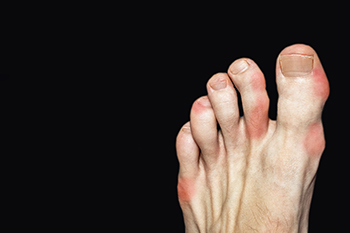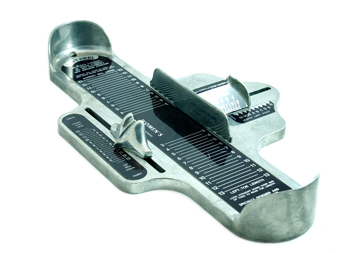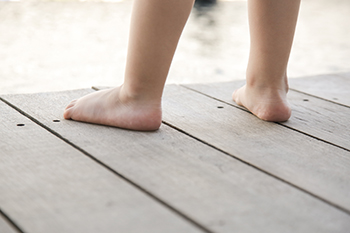Connect With Us
Blog
Items filtered by date: June 2024
Healing From Hammertoe Surgery

Recovering from hammertoe surgery requires attentive care to ensure proper healing and prevent complications. Follow your doctor's instructions regarding pain relief and any prescribed antibiotics to avoid infection. Keeping the pain under control will also help you stay mobile and adhere to post-surgery exercises. A balanced diet rich in vitamins and minerals supports the healing process, with particular emphasis on nutrients like vitamin C and protein to aid tissue repair. Incision care is vital for preventing infections includes keeping the surgical site clean and dry and following your podiatrist's guidelines on changing dressings. Avoid soaking the foot until the incision is fully healed, and watch for signs of infection like increased redness, swelling, or discharge. Elevating the foot and limiting activity as recommended will reduce swelling and promote faster recovery. If you have had hammertoe surgery, it is suggested that you keep in close contact with your podiatrist who can monitor your recovery.
Foot surgery is sometimes necessary to treat a foot ailment. To learn more, contact Michael Tomey, DPM of Cary Foot & Ankle Specialists. Our doctor will assist you with all of your foot and ankle needs.
When Is Surgery Necessary?
Foot and ankle surgery is generally reserved for cases in which less invasive, conservative procedures have failed to alleviate the problem. Some of the cases in which surgery may be necessary include:
- Removing foot deformities like bunions and bone spurs
- Severe arthritis that has caused bone issues
- Cosmetic reconstruction
What Types of Surgery Are There?
The type of surgery you receive will depend on the nature of the problem you have. Some of the possible surgeries include:
- Bunionectomy for painful bunions
- Surgical fusion for realignment of bones
- Neuropathy decompression surgery to treat nerve damage
Benefits of Surgery
Although surgery is usually a last resort, it can provide more complete pain relief compared to non-surgical methods and may allow you to finally resume full activity.
Surgical techniques have also become increasingly sophisticated. Techniques like endoscopic surgery allow for smaller incisions and faster recovery times.
If you have any questions please feel free to contact our office located in Cary, NC . We offer the newest diagnostic and treatment technologies for all your foot and ankle needs.
How Gout Affects Feet
 Gout is a type of arthritis that causes sudden, severe attacks of pain, redness, and tenderness in joints, often affecting the feet. It occurs when urate crystals accumulate in the joints, causing inflammation and intense pain. These crystals form when there are high levels of uric acid in the blood. The body produces uric acid when it breaks down purines, substances found naturally in the body, and certain foods. Gout can affect anyone, but it is more common in men, postmenopausal women, and individuals with kidney disease or a family history of gout. In the feet, gout typically impacts the big toe, but it can also affect other parts like the ankles and heels. The pain can be excruciating, described as a burning or stabbing sensation, often waking individuals from sleep. Swelling, redness, and warmth in the affected area are common symptoms. To manage gout, lifestyle changes such as diet modification, weight loss, and avoiding alcohol are recommended. Medications to reduce uric acid levels and inflammation may also be prescribed. If you experience severe foot pain due to gout, it is suggested that you schedule an appointment with a podiatrist for targeted treatment and management strategies.
Gout is a type of arthritis that causes sudden, severe attacks of pain, redness, and tenderness in joints, often affecting the feet. It occurs when urate crystals accumulate in the joints, causing inflammation and intense pain. These crystals form when there are high levels of uric acid in the blood. The body produces uric acid when it breaks down purines, substances found naturally in the body, and certain foods. Gout can affect anyone, but it is more common in men, postmenopausal women, and individuals with kidney disease or a family history of gout. In the feet, gout typically impacts the big toe, but it can also affect other parts like the ankles and heels. The pain can be excruciating, described as a burning or stabbing sensation, often waking individuals from sleep. Swelling, redness, and warmth in the affected area are common symptoms. To manage gout, lifestyle changes such as diet modification, weight loss, and avoiding alcohol are recommended. Medications to reduce uric acid levels and inflammation may also be prescribed. If you experience severe foot pain due to gout, it is suggested that you schedule an appointment with a podiatrist for targeted treatment and management strategies.
Gout is a foot condition that requires certain treatment and care. If you are seeking treatment, contact Michael Tomey, DPM from Cary Foot & Ankle Specialists. Our doctor will treat your foot and ankle needs.
What Is Gout?
Gout is a type of arthritis caused by a buildup of uric acid in the bloodstream. It often develops in the foot, especially the big toe area, although it can manifest in other parts of the body as well. Gout can make walking and standing very painful and is especially common in diabetics and the obese.
People typically get gout because of a poor diet. Genetic predisposition is also a factor. The children of parents who have had gout frequently have a chance of developing it themselves.
Gout can easily be identified by redness and inflammation of the big toe and the surrounding areas of the foot. Other symptoms include extreme fatigue, joint pain, and running high fevers. Sometimes corticosteroid drugs can be prescribed to treat gout, but the best way to combat this disease is to get more exercise and eat a better diet.
If you have any questions please feel free to contact our office located in Cary, NC . We offer the newest diagnostic and treatment technologies for all your foot and ankle needs.
Heel Pain Can Be Treated!
Shoe Fitting Tests for Older Adults Using a Brannock Device and 3D Foot Scanning

Ensuring accurate shoe fitting in older adults is essential for comfort and mobility. The Brannock device, a traditional tool used for decades, measures foot length and width manually. While it is reliable for basic measurements, it does not capture the full complexity of foot shape. In contrast, three-dimensional, or 3D, foot scanning technology offers a more comprehensive analysis. This advanced method creates a detailed digital model of the foot, accounting for variations in arch height, toe shape, and other nuances. Older adults, who often experience changes in foot structure due to aging, can benefit significantly from the precision of 3-D scanning. This technology provides tailored recommendations, enhancing both comfort and support. Although the Brannock device remains a valuable tool, the detailed insights from 3-D foot scanning represent a significant advancement in ensuring the best fit for older individuals. If you are wearing shoes that do not fit properly and have developed a foot condition, it is suggested that you visit a podiatrist who can help you with relief options and guide you on the best way to determine your shoe size.
Finding a properly-fitting shoe is important in reducing injuries and preventing foot problems. For more information about treatment, contact Michael Tomey, DPM from Cary Foot & Ankle Specialists. Our doctor will treat your foot and ankle needs.
Proper Shoe Fitting
A common concern when it comes to foot health, having properly fitted shoes can help prevent injuries to the foot. Out feet affect our posture and gait, which in turn affects the biomechanics and overall bodily structure. With 33 joints, 26 bones, and over 100 ligaments, the potential for serious injury is much greater than one realizes. Although the feet cease growth in adulthood, they still change shape as they mature. Here are some factors to consider when it comes to investing in proper fitting shoes:
- Be sure the shoes fit correctly right away
- Ensure the ball of your foot fits comfortably in the widest portion of the shoes
- Even though they may look fashionable, improper fitting shoes can either create adverse conditions or exacerbate existing ones you may already have
- Walk along a carpeted surface to ensure the shoes comfortably fit during normal activity
Keeping in mind how shoes fit the biomechanics of your body, properly-fitting shoes are vitally important. Fortunately, it is not difficult to acquire footwear that fits correctly. Be sure to wear shoes that support the overall structure of your body. Do your feet a favor and invest in several pairs of well-fitted shoes today.
If you have any questions please feel free to contact our office located in Cary, NC . We offer the newest diagnostic and treatment technologies for all your foot and ankle needs.
Flat Feet and Overpronation
 Flat feet, a condition where the arches of the feet touch the ground when you stand, can lead to overpronation. Overpronation occurs when the ankles roll excessively inward with each step during walking or running. This can cause additional strain on the ankles, knees, and hips. Overpronation can also increase the risk of injuries and discomfort due to improper alignment and distribution of body weight. People with flat feet may experience fatigue in their feet and legs, and suffer from pain in the heel or arch area. To help manage symptoms of flat feet and any issues resulting from overpronation, a podiatrist, or foot doctor, may recommend orthotic devices. These are insoles that fit into shoes to provide support for the arches, correct the pronation, and enhance overall foot function. Proper footwear that offers stability and support is also important to effectively manage overpronation. Regular check-ups with a podiatrist can ensure that individuals with flat feet receive the necessary support and guidance to prevent any issues. If you have flat feet, or suspect overpronation when walking, it is suggested you make an appointment with a podiatrist for a full exam and possible gait analysis.
Flat feet, a condition where the arches of the feet touch the ground when you stand, can lead to overpronation. Overpronation occurs when the ankles roll excessively inward with each step during walking or running. This can cause additional strain on the ankles, knees, and hips. Overpronation can also increase the risk of injuries and discomfort due to improper alignment and distribution of body weight. People with flat feet may experience fatigue in their feet and legs, and suffer from pain in the heel or arch area. To help manage symptoms of flat feet and any issues resulting from overpronation, a podiatrist, or foot doctor, may recommend orthotic devices. These are insoles that fit into shoes to provide support for the arches, correct the pronation, and enhance overall foot function. Proper footwear that offers stability and support is also important to effectively manage overpronation. Regular check-ups with a podiatrist can ensure that individuals with flat feet receive the necessary support and guidance to prevent any issues. If you have flat feet, or suspect overpronation when walking, it is suggested you make an appointment with a podiatrist for a full exam and possible gait analysis.
Flatfoot is a condition many people suffer from. If you have flat feet, contact Michael Tomey, DPM from Cary Foot & Ankle Specialists. Our doctor will treat your foot and ankle needs.
What Are Flat Feet?
Flatfoot is a condition in which the arch of the foot is depressed and the sole of the foot is almost completely in contact with the ground. About 20-30% of the population generally has flat feet because their arches never formed during growth.
Conditions & Problems:
Having flat feet makes it difficult to run or walk because of the stress placed on the ankles.
Alignment – The general alignment of your legs can be disrupted, because the ankles move inward which can cause major discomfort.
Knees – If you have complications with your knees, flat feet can be a contributor to arthritis in that area.
Symptoms
- Pain around the heel or arch area
- Trouble standing on the tip toe
- Swelling around the inside of the ankle
- Flat look to one or both feet
- Having your shoes feel uneven when worn
Treatment
If you are experiencing pain and stress on the foot you may weaken the posterior tibial tendon, which runs around the inside of the ankle.
If you have any questions please feel free to contact our office located in Cary, NC . We offer the newest diagnostic and treatment technologies for all your foot and ankle needs.

